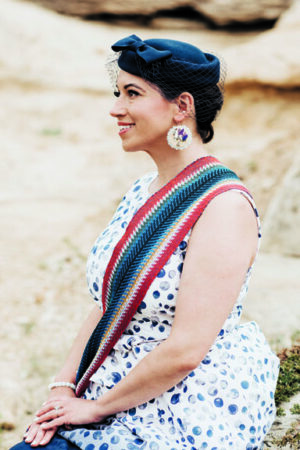Miywasin Moment: Brides in braids – Indigenous wedding traditions, Part 1
By JoLynn Parenteau on June 8, 2022.
The writer incorporated Métis and First Nations elements into her wedding day. Custom lilac bouquet beaded earrings by Mohawk artist Karakwenta Heather Berry, pinkpohawk.com.--PORTRAIT BY BRITTANY ROSS PHOTO
June is National Indigenous History Month, recognizing the rich diversity, heritage and history of First Nations, Inuit and Métis Peoples across Northern Turtle Island (Canada).
June also commonly observes the start of wedding season. As a newlywed myself, this two-part series of the Miywasin Moment explores Indigenous wedding traditions across Turtle Island and how I incorporated some into my own wedding to reflect my paternal Métis-Cree heritage.
Métis unions
The Métis People were born of unions primarily between First Nations women and European fur traders. Generations on, Métis weddings were unique with guests dressed in traditional attire, women in ribbon skirts and men in voyageur shirts, beaded vests and many wore the colourful Métis sash. I was proud to have my bridal portrait taken wearing my Métis sash, the pattern distinctive to Miywasin Friendship Centre.
The wedding feast was prepared by the community’s women, who would line the fire pit with a fresh set of stones. A cast-iron pot was hung for boiling corn. Buffalo was the primary food source in addition to moose, elk, prairie bush rabbits and wild birds. Along with the traditional galette (bannock), the wedding meal included les beignes (fried bread), les boulettes (meatballs), le rababou (stew), molasses cakes and wild berries. Our wedding cake featured Saskatoon berry filling, a favourite berry of the Métis.
Métis weddings are celebrated with much joie de vivre. The Métis dance style which accompanies fiddle music is adapted from Celtic and French-Canadian origins, but seamlessly weaves in faster-paced First Nations rhythm and steps and rhythms that accompany traditional drumming.
Inuit marriages
Parents often arranged marriages for their children, though love matches were allowed if the social status of the bride and groom was acceptable to both sides. A young man might join the bride’s household, working as a premarital bride-service for the father-in-law. At other times, important gifts such as sleds could be offered as a bride price. Unions were informal, with the couple merely setting up a separate home for themselves.
First Nations wedding traditions
Just as the languages and homelands vary widely among First Nations clans, so too do their wedding traditions. The practices shared here are general in nature, unless specified to a particular clan or tribe.
Before ceremonies and celebrations, family members braid each other’s hair to reinforce the sacred bonds of relationships. It is said that a single strand of hair is weak, but braided hair is strong.
This teaching about the symbolism of the braid reaffirms the value of the family and clan along with our connection to all of creation. In the American Hopi tribe, on the morning of the wedding, female relatives washed and braided the couple’s hair together to signify their lifelong union.
With hair still interwoven the bride and groom would walk to the mesa’s edge to pray to the rising sun. I wore my hair in two braids wound in a knot to honour the joining of our two families.
Wedding ceremonies were typically held in the evening, outdoors at a natural sacred site or in a spiritual lodge or arbor (wooden shelter), reflecting the close relationship tribes have with Mother Earth. Tribal leaders were consulted to select the site, date and time for the wedding.
Everyone was invited by word of mouth. The ceremony was officiated by the Pipe Carrier, who ensured the couple was very serious, for even if they later separated, it was believed they would still be married in the eyes of the Creator. The couple would declare their choice to be wed, then they would smoke from the pipe.
Water was used as a symbol of purification. The couple cleansed their hands with water often poured from a gourd in a ceremony to wash away past loves. The couple was then wrapped in a blanket and smudged together, cleansed with the smoke from sacred medicines such as sweetgrass.
The Cherokee bride and groom would choose four sponsors: older, well respected persons to give spiritual and marital guidance throughout the couple’s marriage. At the wedding, the sponsors would promise to help the new couple.
Marriage brought increased status to both the husband and the wife. Marital and kinship relationships in general were governed by rigid rules of etiquette, as related families often made up large households to share resources. The new husband was responsible for hunting for his in-laws. The wife cared for her in-laws and her own as they aged.
Next week’s Miywasin Moment brings you Part 2 of Brides in braids: Indigenous wedding traditions.
JoLynn Parenteau is a newlywed Métis writer out of Miywasin Friendship Centre. Column feedback can be sent to
jolynn.parenteau@gmail.com
21
-20
 The writer incorporated Métis and First Nations elements into her wedding day. Custom lilac bouquet beaded earrings by Mohawk artist Karakwenta Heather Berry, pinkpohawk.com.--PORTRAIT BY BRITTANY ROSS PHOTO
The writer incorporated Métis and First Nations elements into her wedding day. Custom lilac bouquet beaded earrings by Mohawk artist Karakwenta Heather Berry, pinkpohawk.com.--PORTRAIT BY BRITTANY ROSS PHOTO

